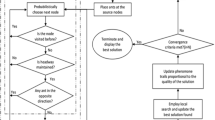Abstract
A travel or transport path reflects the settlement pattern and the spread of civilization. Travel simulations of the pre-Qin period of the Central Plains of China can deepen our understanding of the origin and development of Chinese civilization. Here, based on the idea of swarm intelligence, an ant colony optimization algorithm based on gradient descent and variable-neighborhood search (GD-VNSACO) methods is proposed to simulate the travel routes of ancestors. We simulate the process of humans gradually exploring the surrounding space and obtaining experience and inspiration in four cultural periods from 7 to 2.7 ka B.P. (including the Yangshao Period, Miaodigou II Period, Longshan Period and Xia Shang and Zhou Period). The GD-VNSACO algorithm is suitable for studying settlement travel because of its improved search ability and convergence speed based on local and overall optimization. We conclude that in the four periods, the high-density routes of transport were concentrated along the Fen River, forming a main line from north to south. Over time, high-density areas of transport and communication among settlements, as well as the transport scope, expanded. However, there was an abnormality in the Miaodigou II Period, which was mainly caused by the climate becoming dryer and colder.











Similar content being viewed by others
References
Bell T, Wickham WA (2002) Tracking the Samnites: landscape and communications routes in the Sangro Valley, Italy. Am J Archaeol 106(2):169–186
Dijkstra EW (1976) A discipline of programming. Prentice Hall, Englewood Cliffs
Dorigo M, Gambardella LM (1997) Ant colony system: a cooperative learning approach to the traveling salesman problem. IEEE Trans Evol Comput 1(1):53–66
Duncan OD (1966) Path analysis: sociological examples. Am J Sociol 72(1):1–16
Gao TL, Zhang DH (1980) Excavation briefing of Taosi site in Xiangfen County, Shanxi Province. Archaeology (1):18-31. In Chinese
Guo HB, Cao CM, Zhang TX (2012) Excavation report of Nan Xiaozhang site in Xiangfen County. Three-Jin Archeology 01:255–273 In Chinese
Howey MCL (2007) Using multi-criteria cost surface analysis to explore past regional landscapes: a case study of ritual activity and social interaction in Michigan, AD 1200–1600. J Archaeol Sci 34(11):1830–1846
Huang CC, Pang J, Su H (2007) Climatic and anthropogenic impacts on soil formation in the semiarid loess tablelands in the middle reaches of the Yellow River, China. J Arid Environ 71(3):280–298
Kivinen J, Manfred KW (1997) Exponentiated gradient versus gradient descent for linear predictors. Inf Comput 132(1):1–63
Li J (1983) Archaeological survey of the Fen River basin in southern Shanxi. Archaeology 8:759–766 In Chinese
Li ZX, Zhu C, Yuan SY et al (2015) Geographical distribution, diffusion and subsistence variation of prehis- toric cultures in Nanyang Basin, Henan Province. Acta Geograph Sin 70(1):143–156 In Chinese
Liang ZM, Chang HX; Xue XM (1996) Investigation and excavation report of Dongxu site in Quwo county, Shanxi. Three-Jin Archaeology, 220–244. In Chinese
Liu F, Yu L, Ys N, Zhu J (2019) Spatiotemporal analysis of prehistoric settlement clustering based on terrain constraints in the Linfen area of China. Geoarchaeology 34(5):565–580
Groenhuijzen MR, Verhagen P (2015) Exploring the dynamics of transport in the dutch limes. Etopoi Journal for Ancient Studies Special Volume 4: 25–47
Mladenović N, Hansen P (1997) Variable neighborhood search. Comput Oper Res 24(11):1097–21100
Rivero J, Cuadra D, Calle J, Isasi P (2012) Using the ACO algorithm for path searches in social networks. Appl Intell 36(4):899–917
Stützle T, Hoos HH (2000) MAX–MIN Ant System. Futur Gener Comput Syst 16(8):889–914
Van LR et al (2015) Best travel options: Modelling Roman and early-medieval routes in the Netherlands using a multi-proxy approach. J Archaeol Sci Rep 3:144–159
Wu WX, Fang Q, Ge QS (2012) Climatic changes during the Longshan period (5.5-4.0kaBP). Mar Geol Quat Geol 33(6):129–137
Yan ZB, He N (2005) Excavation report of the site of the Tao Tao Temple site in Shanxi in 2002. Acta Archaeol Sin (03):71–110 In Chinese
Yang LZ et al (1992) Investigation report of the four site in Yichen county. World Antiquity (2):16–21 In Chinese
Zhou L, Li Z, Shi N, Liu S, Xiong K (2019) Performance analysis of three intelligent algorithms on route selection of fishbone layout. Sustainability. 11(4):1148
Zhu JF, Nie YP, Gao HG et al (2017) GIS-based visibility network and defensibility model to reconstruct defensive system of the Han dynasty in Central Xinjiang, China. ISPRS Int J Geo Inf 6(8):247
Acknowledgments
The authors thank the anonymous reviewers for their valuable comments.
Funding
The paper was supported by National Key Research and Development Project of China under grant agreement No. 2020YFC1521900 and 2020YFC1521901.This paper also has received funding from the National Natural Science Foundation of China (No. 41801134).
Author information
Authors and Affiliations
Contributions
Conceptualization, F.L. and L.Y.; Methodology, F.L.; Software, Y.S.; Formal Analysis, F.L.; Investigation, F.L. and L.Y.; Data Curation, Y.S.; Writing – Original Draft Preparation, F.L.; Writing – Review & Editing, J.Z. and F.L.; Visualization, F.L. and J.Z.; Project Administration, Y.N. and L.Y.; Funding Acquisition, L.Y. and J.Z.
Corresponding author
Ethics declarations
Conflict of interest
The authors declare no conflicts of interest.
Additional information
Communicated by: H. Babaie
Publisher’s note
Springer Nature remains neutral with regard to jurisdictional claims in published maps and institutional affiliations.
Rights and permissions
About this article
Cite this article
Liu, F., Yu, L., Zhu, J. et al. Trip route simulation for pre-Qin settlements based on a gradient descent and variable-neighborhood ant colony optimization algorithm in the Linfen Basin, China. Earth Sci Inform 14, 415–428 (2021). https://doi.org/10.1007/s12145-020-00556-4
Received:
Accepted:
Published:
Issue Date:
DOI: https://doi.org/10.1007/s12145-020-00556-4




